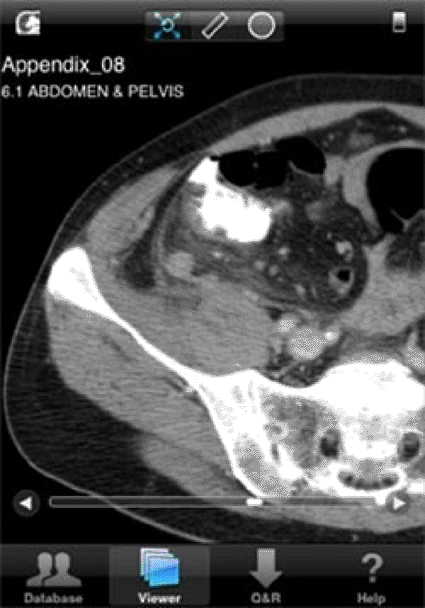Smartphones Assist Remote Diagnosis of Acute Appendicitis
By MedImaging International staff writers
Posted on 11 Dec 2009
Special software allows viewing of raw clinical image data in full resolution, allowing acute appendicitis to be accurately diagnosed from a remote location by a radiologist using an iPhone. Posted on 11 Dec 2009
Researchers at Johns Hopkins University (JHU, Baltimore, MD, USA) and the University of Virginia (Charlottesville, CT, USA) performed abdomen and pelvis computerized tomography (CT) studies on 25 patients with pain in the right lower abdomen. All patients had either surgical confirmation of the diagnosis of acute appendicitis, or follow-up clinical evaluation confirming no acute appendicitis. Each study was viewed by five blinded radiologists on a handheld device (iPhone 3G), equipped with OsiriX open source mobile medical image viewing software. The studies were evaluated for the ability to find the appendix, the maximum appendiceal diameter, presence of an appendicolith, periappendicial stranding and fluid, abscess formation, and a binary assessment of the diagnosis of acute appendicitis. The studies were also compared to a faculty-read of the study as performed on a dedicated picture archiving and communication system (PACS) workstation.

Image: The appendix as viewed on an iPhone 3G (Photo courtesy of Dr. A Choudhri - RSNA org.).
The results showed that 15 of the 25 patients were correctly identified as having acute appendicitis on 74 (99%) of 75 interpretations, with one false negative; there were no false positive readings. In eight of the 15 patients who had appendicitis, calcified deposits within the appendix were correctly identified in 88% of the interpretations. All 15 patients had signs of inflammation near the appendix that were correctly identified in 96% of interpretations, and 10 of the 15 had fluid near the appendix, which was correctly identified in 94% of the interpretations. Three abscesses were correctly identified by all five readers. However, handheld device measurements of the appendix averaged almost one millimeter larger than measurements on the PACS workstation, suggesting that appedendical diameter should not be used as the sole basis for diagnosis. The study results were presented at the annual meeting of the Radiological Society of North America (RSNA), held during November-December 2009 in Chicago (IL, USA).
"The iPhone interpretations of the CT scans were as accurate as the interpretations viewed on dedicated PACS workstations,” said lead author Asim Choudhri, M.D., of the division of neuroradiology at JHU. "The scans can be read in full resolution with very little panning, and the software allows the reader to zoom and adjust the contrast and brightness of the image. The radiologist is evaluating actual raw image data, not snapshots.”
The researchers concluded that remote viewing of studies may be feasible for emergent consultation to expedite emergency room care when consultation with a specialist is needed, which could be of particular benefit for subspecialist consultation for on-call residents.
Related Links:
Johns Hopkins University
University of Virginia














